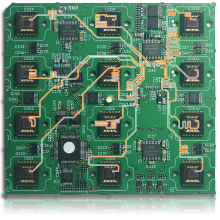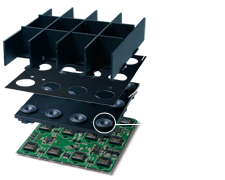
Multi-CCD Detector Method
12 CCD sensors are combined into one unit and then multiple units structure a single NAOMI sensor. This is RF's unique technology for high image quality and affordable price.
CCD Unit Substrate
The signal lines between control components and each CCD sensor are designed with the same length in order for 12 CCDs to receive the command at the same time. Normally, a single CCD makes a pair with a single control component to operate. However on Multi-CCD Detector Method, a single control component can send the command to multiple CCD sensors. By drastically reducing the number of components with this method, it has achieved the exceptional production cost reduction, high image quality and affordable retail price.

It has 10 layers of substrates even though it may seem like a plain board at a glance (Multi-Layer Board). This is to avoid each signal line to intersect with each other. Therefore these signal lines are placed as if they threaded their ways through the multiple layers of computer boards.

Antireflection Sheet
The resin with 0.2% reflectivity cuts the reflection of light around lenses by 99.8%. It sharpens the image by preventing the reflection.
Lens Bracket
In order to capture images without distortion, lenses must be perpendicular to the substrate. As positing screw ports requires high accuracy, the tolerance difference is standardized below±0.02. The main unit is treated with the special material, which prevents warping and camber (Double Earning Processing).
Lens Screw Pitch: 0.5mm

The screw pitch is 0.5mm, less than a half of standard product. The pitch is finely etched to be able to adjust the focus more precisely.

Carbon Plate
To achieve high x-ray transmittance and block the other outside lights at the same time, a carbon plate is used for the front face of the sensor case.
Light Shielding Unit
Grid-partition shields the incoming light from the adjacent area. The antireflection coating and material are used on the shields to prevent any light reflection.
Scintillator
It converts the x-ray to visible light. Usually a scintillator is treated with embossing finish, but NAOMI's scintillator is treated with special mirror-like finish. The CCD sensors capture the light that passes through the scintillator.
Chassis
The sensor chassis is made of an shock-resistance resin material. Superiority of this material is well known in formability, durability and weather resistance that it is commonly used for traveler's luggage and interior of vehicles.
Power Module
A separate miniature power module is placed on the four sides of the sensor to evenly provide the power to the entire sensor. It reduces the heat and noise caused by operation.
Main Substrate
It sends the commands to sub-boards and controls the entire sensor.
